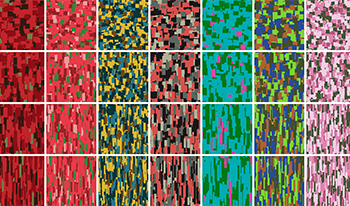References
1AndersonB. L.KimJ.2009Image statistics for surface reflectance perceptionJ. Vis.91171–17
2BeckJ.1972Similarity grouping and peripheral discriminability under uncertaintyAm. J. Psychol.851191–1910.2307/1420955
3BergenJ. R.ReganD.Theories of visual texture perceptionSpatial Vision, ser. Vision and Visual Dysfunction1991Vol. 10CRC PressCambridge, MA114134114–34
4BesagJ.1974Spatial interaction and the statistical analysis of lattice systemsJ. Royal Statist. Soc. B26192236192–236
5BesagJ.1986On the statistical analysis of dirty picturesJ. Royal Statist. Soc. B48259302259–302
6BordenaveC.GousseauY.RoueffF.2006The dead leaves model: a general tessellation modeling occlusionAdv. Appl. Probab.38314631–4610.1239/aap/1143936138
7ChenJ.PappasT. N.MojsilovicA.RogowitzB. E.2005Adaptive perceptual color-texture image segmentationIEEE Trans. Image Process.14152415361524–3610.1109/TIP.2005.852204
8ChubbC.DarcyJ.LandyM.EconopoulyJ.NamJ.BindmanD.SperlingG.ShapiroA. G.TodorovicD.The scramble illusion: Texture metamersOxford Compendium of Visual Illusions2015Oxford University PressNew York
9DengY.ManjunathB. S.KenneyC.MooreM. S.ShinH.2001An efficient color representation for image retrievalIEEE Trans. Image Process.10140147140–710.1109/83.892450
10DoM. N.VetterliM.2000Texture similarity measurement using Kullback-Leibler distance on wavelet subbandsProc. Int. Conf. Image Proc.3730733730–3
11EdwardsA. L.Techniques of Attitude Scale Construction1983Ardent MediaNew York, NY
12ElliottS. L.HardyJ. L.WebsterM. A.WernerJ. S.2007Aging and blur adaptationJ. Vis.7191–910.1167/7.6.8
13EskewR. T.BoyntonR. M.1987Effects of field area and configuration on chromatic and border discriminationVis. Res.27183518441835–4410.1016/0042-6989(87)90112-X
14HeL.
15HeL.PappasT. N.An adaptive clustering and chrominance-based merging approach for image segmentation and abstractionProc. Int’l. Conf. Image Proc.2010IEEEPiscataway, NJ241244241–4
16HoY.-X.LandyM. S.MaloneyL. T.2006How direction of illumination affects visually perceived surface roughnessJ. Vis.6634648634–4810.1167/6.5.8
17HoY.-X.LandyM. S.MaloneyL. T.2008Conjoint measurement of gloss and surface texturePsychological Sci.19196204196–20410.1111/j.1467-9280.2008.02067.x
18HoY.-X.MaloneyL. T.LandyM. S.2007The effect of viewpoint on perceived visual roughnessJ. Vis.11161–1610.1167/7.1.1
19JuleszB.1962Visual pattern discriminationIRE Trans. Inf. Theory8849284–9210.1109/TIT.1962.1057698
20JuleszB.1981Textons, the elements of texture perception and their interactionsNature290919791–710.1038/290091a0
21JuleszB.RogowitzB. E.RogowitzB. E.AI and early vision – Part IIHuman Vision, Visual Proc., and Digital Display, Ser. Proc. SPIE1989Vol. 1077SPIE, Los Angeles, CA246268246–68
22KimuraE.2018Averaging colors of multicolor mosaicsJ. Opt. Soc. Am. A35B43B54B43–5410.1364/JOSAA.35.000B43
23KindermannR.SnellJ. L.Markov Random Fields and their Applications1980American Mathematical SocietyProvidence, RI
24KingdomF. A. A.Interactions of Color Vision with Other Visual Modalities2016SpringerCham219241219–41
25KurikiI.2004Testing the possibility of average-color perception from multi-colored patternsOpt. Rev.11249257249–5710.1007/s10043-004-0249-2
26LandyM. S.WernerJ. S.ChalupaL. M.2014Texture analysis and perceptionThe New Visual Neurosciences639652639–52MIT PressCambridge, MA
27LeeA. B.MumfordD.HuangJ.2001Occlusion models for natural images: A statistical study of a scale-invariant dead leaves modelInt. J. Comput. Vis.41353935–910.1023/A:1011109015675
28LindeY.BuzoA.GrayR. M.1980An algorithm for vector quantizer designIEEE Trans. Commun.COM-28849584–9510.1109/TCOM.1980.1094577
29MaW. Y.DengY.ManjunathB. S.RogowitzB. E.PappasT. N.Tools for texture/color based search of imagesHuman Vision and Electronic Imaging II. Proc. SPIE1997Vol. 3016SPIE, San Jose, CA496507496–507
30ManjunathB. S.MaW. Y.1996Texture features for browsing and retrieval of image dataIEEE Trans. Pattern Anal. Mach. Intell.18837842837–4210.1109/34.531803
31ManjunathB. S.OhmJ.-R.VasudevanV. V.YamadaA.2001Color and texture descriptorsIEEE Trans. Circuits Syst. Video Technol.11703715703–1510.1109/76.927424
32MannosJ. L.SakrisonD. J.1974The effects of a visual fidelity criterion on the encoding of imagesIEEE Trans. Inform. TheoryIT-20525536525–3610.1109/TIT.1974.1055250
33
34MarlowP. J.KimJ.AndersonB. L.2012The perception and misperception of specular surface reflectanceCurrent Biology22190919131909–1310.1016/j.cub.2012.08.009
35MatheronG.Random Sets and Integral Geometry1975John Wiley and SonsNew York
36MauleJ.FranklinA.2016Accurate rapid averaging of multihue ensembles is due to a limited capacity subsampling mechanismJ. Opt. Soc. Am. A33A22A29A22–910.1364/JOSAA.33.000A22
37MojsilovićA.HuJ.SoljaninE.2002Extraction of perceptually important colors and similarity measurement for image matching, retrieval, and analysisIEEE Trans. Image Process.11123812481238–4810.1109/TIP.2002.804260
38MojsilovićA.KovačevićJ.HuJ.SafranekR. J.GanapathyS. K.2000Matching and retrieval based on the vocabulary and grammar of color patternsIEEE Trans. Image Process.1385438–5410.1109/83.817597
39MotoyoshiI.NishidaS.SharanL.AdelsonE. H.2007Image statistics and the perception of surface qualitiesNature447206209206–910.1038/nature05724
40OjalaT.PietikäinenM.MäenpääT.2002Multiresolution gray-scale and rotation invariant texture classification with local binary patternsIEEE Trans. Pattern Anal. Mach. Intell.24971987971–8710.1109/TPAMI.2002.1017623
41OmerI.WermanM.Color lines: Image specific color representationIEEE Conf. Computer Vision and Pattern Recognition (CVPR)2004IEEEPiscataway, NJ946953946–53
42PadillaS.DrbohlavO.GreenP. R.SpenceA.ChantlerM. J.2008Perceived roughness of 1/f[beta] noise surfacesVis. Res.48179117971791–710.1016/j.visres.2008.05.015
43PappasT. N.1992An adaptive clustering algorithm for image segmentationIEEE Trans. Signal Process.SP-40901914901–1410.1109/78.127962
44PappasT. N.ChenJ.DepalovD.2007Perceptually based techniques for image segmentation and semantic classificationIEEE Commun. Mag.45445144–5110.1109/MCOM.2007.284537
45PappasT. N.NeuhoffD. L.de RidderH.ZujovicJ.2013Image analysis: Focus on texture similarityProc. IEEE101204420572044–5710.1109/JPROC.2013.2262912
46ParvatiK.RaoP.DasM. M.
47PinnaB.GrossbergS.2005The watercolor illusion and neon color spreading: a unified analysis of new cases and neural mechanismsJ. Opt. Soc. Am. A22220722212207–2110.1364/JOSAA.22.002207
48PoirsonA. B.WandellB. A.1993Appearance of colored patterns: pattern-color separabilityJ. Opt. Soc. Am. A10245824702458–7010.1364/JOSAA.10.002458
49RubnerY.TomasiC.GuibasL. J.2000The earth mover’s distance as a metric for image retrievalInt. J. Comput. Vis.409912199–12110.1023/A:1026543900054
50SawhneyH. S.HafnerJ. L.Efficient color histogram indexingProc. Int’l. Conf. Image Proc.1994IEEE Computer Society, Washington, DC667066–70
51SilverN. C.DunlapW. P.1987Averaging correlation coefficients: Should Fisher’s z transformation be used?J. Appl. Psychology7214610.1037/0021-9010.72.1.146
52SwainM.BallardD.1991Color indexingInt. J. Computer Vision7113211–3210.1007/BF00130487
53SwitkesE.BradleyA.ValoisK. K. D.1988Contrast dependence and mechanisms of masking interactions among chromatic and luminance gratingsJ. Opt. Soc. Am. A5114911621149–6210.1364/JOSAA.5.001149
54ThurstoneL. L.1927A law of comparative judgmentPsychological Review3427310.1037/h0070288
55TouJ. T.GonzalezR. C.Pattern Recognition Principles1974Addison, Reading, MA
56van DoornA. J.de RidderH.KoenderinkJ. J.RogowitzB. E.PappasT. N.DalyS. J.Pictorial relief for equiluminant imagesHuman Vision and Electronic Imaging X, Ser. Proc. SPIE2005Vol. 5666SPIE, San Jose, CA
57WebsterJ.KayP.WebsterM. A.2014Perceiving the average hue of color arraysJ. Opt. Soc. Am. A31A283A292A283–9210.1364/JOSAA.31.00A283
58WijntjesM. W. A.PontS. C.2010Illusory gloss on Lambertian surfacesJ. Vis.101121–1210.1167/10.9.13
59ZujovicJ.
60ZujovicJ.PappasT. N.NeuhoffD. L.Structural similarity metrics for texture analysis and retrievalProc. Int’l. Conf. Image Proc.2009IEEEPiscataway, NJ222522282225–8
61ZujovicJ.PappasT. N.NeuhoffD. L.2013Structural texture similarity metrics for image analysis and retrievalIEEE Trans. Image Process.22254525582545–5810.1109/TIP.2013.2251645

 Find this author on Google Scholar
Find this author on Google Scholar Find this author on PubMed
Find this author on PubMed